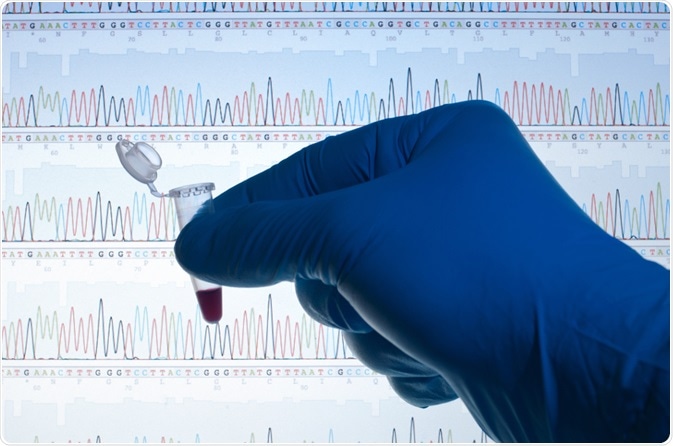Since the inception of forensic DNA analysis in the 1980s, the processes surrounding the criminal justice system have been revolutionized, with many millions having been proven guilty or innocent with the aid of DNA evidence.

Forensic DNA. Image Credit: damerau/Shutterstock.com
Similarly, DNA evidence has assisted in tracing the identity of missing individuals, identifying the remains of those involved in natural disasters, and uncovering the burial site and modern heritage of historical figures.
Short tandem repeat typing is the most commonly utilized type of forensic DNA analysis. Short tandem repeats are abundant throughout the genome, though a specific subset of loci is usually selected for genetic fingerprinting. Comparison of the genetic fingerprint obtained from evidence collected at a crime scene with a known sample from, say, the suspect, allows their presence to be confirmed.
DNA databases of criminals have been assembled around the world, meaning that the sample can be screened against a large pool of individuals in a high throughput computational manner. As discussed, DNA can also be used to establish genetic relationships between people, and criminals have been identified by DNA testing of close relatives in the past.
Recent improvements in DNA analysis
Forensic DNA analysis has improved significantly over the last several decades, becoming faster, cheaper, and more accessible to the point of DNA swabs being routine for even minor crimes, generating a huge backlog of forensic evidence. The capacity to conduct and capabilities of forensic analysis will likely continue to expand over the coming decades, becoming, faster, more sensitive, and less costly.
Fully automated DNA profiling systems have been introduced that can extract, amplify, separate, and genotype samples in less than 90 minutes, though operation costs are somewhat prohibitive to wide-scale adoption. It is thought that these devices could be placed at police stations to allow individuals to be charged with a crime within the short period they may legally be held.
Currently, the most time-consuming stage of DNA analysis is frequently PCR amplification, which requires multiple heating and cooling cycles to generate sufficient DNA for analysis. Numerous methods of faster PCR amplification are in development, such as micro-PCR machines that work with smaller volumes of liquid and can thus heat or cool more quickly.
PCR amplification can result in stochastic effects, where early overrepresentation of one allele results in the underrepresentation or even exclusion of other alleles. Improved sensitivity in forensic DNA analysis could be achieved by better-established procedures in the future, with computational simulations playing a role in estimating the influence of various contributors to this phenomenon.
Next-generation sequencing (NGS) can be used for whole-exome sequencing of chromosomal and mitochondrial DNA, though is more commonly used in a research setting. Future forensic DNA analysis will include a greatly expanded number of loci that are recorded and thus make highly specific identification and comparison of DNA sequences possible. However, increased data collection then requires more extensive data interpretation, and exhaustive collection beyond the point of probable positive identification in a forensic setting may be unnecessary.
One of the primary aims of forensic DNA sequencing will be improved recovery of challenging samples, those that bear degraded DNA and fail to produce a sufficient genetic profile following ordinary PCR amplification. Smaller PCR amplicons, the DNA or RNA template sequence used to amplify complementary DNA in the sample, can be employed to better replicate degraded DNA, as the complementary sequences are more likely to find the correct partner without introducing incorrect bases.
In the future, it may be possible to predict the genetic profile of an individual without a reference sample, based on known phenotypic features such as eye and hair color, height, ethnicity, and other genetically influenced characteristics. Further, microbial DNA analysis may play a role in placing individuals at a crime scene in the future, as the microbiome is highly specific to individuals, and bacteria can shed by several routes including in the breath, making evidence potentially commonplace and difficult to avoid leaving. The microbiome can also provide evidence as to an individual’s past geolocation, cause of and time since death, and is in some cases is more reliable in leaving evidence of touch than traditional DNA analysis.
Limitations on DNA analysis
Our ability to collect and sequence DNA evidence has, according to experts in the field, outstripped our ability to interpret the results obtained. Calls to improve the consistency of DNA evidence interpretation have been made, and the push for greater communication, centralization, and competition in the forensic DNA supply chain is underway.
Central, focused laboratories are being established in the USA and UK that can better serve the forensic testing requirements of the community than smaller testing stations, though this solution may prove ineffective in less developed regions.
Consistency with previously collected DNA sequences must also be maintained in the future, and expanding the selection of loci recorded produces an escalating quantity of information. Many testing methodologies surrounding the selected loci that are routinely tested in forensic samples have been established at great cost, and thus switching to another set of loci would be expensive.
Similarly, specific personalized testing for features as described above would have high set-up and maintenance costs associated with the operation of such a program, and privacy concerns over DNA databases are also increasingly being raised.
Further Reading